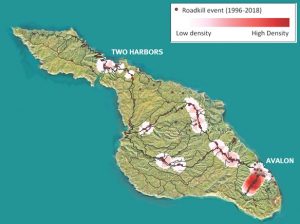

Through careful shepherding and other conservation practices, it appears as though the Catalina Island Conversancy has managed to explode the population of the endemic Catalina Island fox two decades after almost becoming extinct.
Although the fox is enjoying a rebound in its natural habitat, it now faces new peril in highly visited Catalina Island, according to a report released this week by the Santa Catalina Island Conservancy.
“Nearly half of all fox deaths on Catalina are now caused by vehicle strikes,” claims Morgan Robson, Conservancy communications director.
Known simply as “roadkill” to most, the sudden burst of growth in the fox population or the increased vehicle activity across the island are adding up to a threat to this unique island species.
According to the Conservancy, the Catalina Island fox is a subspecies of the Channel Island grey fox and is found only on Catalina.
For the Island Conservancy, the fox is one of 60 animal and plant species that are “endemic” to the island, meaning they are found nowhere else in the world.
“Lately, we have noticed a disturbing frequency of vehicle related mortalities,” she said, noting that a vehicle strike is “an indiscriminate mortality factor that removes otherwise healthy foxes of prime breeding age from the population,” said Robson.
Federal and state wildlife officials placed the Catalina Island fox were very worried when in 1999, the canine distemper virus ravaged the fox population and drove its number down to approximately 100 individuals.
Had the trend continued, the Catalina Island fox would have quickly disappeared from the island, and the planet forever.
In 2004, the U.S. Fish and Wildlife Service placed the Catalina Island fox on its “endangered species list” and the Conservancy went into action.
Teaming up with the highly regarded Institute for Wildlife studies, the Conservancy adopted a three-pronged approach; captive breeding, vaccinating against the distemper virus and annual monitoring of the fox wildlife population.
The plan implemented by the Conservancy began to work and by 2016, the Catalina Island fox was moved from the “endangered list” to the “threatened list. Experts credit the Conservancy staff and specialists for the rebound and “this incredible recovery in the past decade.” According to the Conservancy, the fox population has now zoomed to more than 2,000 individuals, yet they retain every protection against “the enduring threats” to the fox population.
And, “to prevent a recurrence of the population crash,” the Conservancy continues to investigate every fox mortality on the island,” said Robson.
The situation is even more critical because of Catalina’s relatively small size as a land mass, “any deviation (fire, disease, etc.) could decimate the population, so robust protections remain in place. The spokesperson said vehicle strikes of foxes occur “all over the island,” but are most common in a few highly trafficked areas (see graphic). In Avalon, Robson said most fox roadkill incidents occur along Avalon Canyon Road between City Hall and the Wrigley Memorial & Botanic Garden. According to Robson, “there are a few things we can all do as a community to reduce fox mortalities on Catalina roadways.”
The Conservancy is asking motorists to:
• Remember and comply with the island-wide speed limit of 25 mph maximum.
• Be extra alert in areas that are known to be high-risk for foxes (see map), especially during early morning or just before sunset, when foxes tend to be more active.
• Reduce fox attractions near the road,
• Feeding pets indoors rather than on porches or yards
• Securing garbage containers with heavier lids.
• Never feed foxes, especially off the road as this draws them to areas where humans live and where they are more likely to be killed. Finally, citizens are asked to report ANY deceased fox to the Santa Catalina Island Conservancy so that the incidents can be investigated as soon as possible. Report fox incidents to 310-510-1299 x233.
With the public’s help, the Conservancy can “learn more about threats to this federally protected endemic species” to ensure that the population remains “a healthy Catalina Island treasure” for decades to come.










